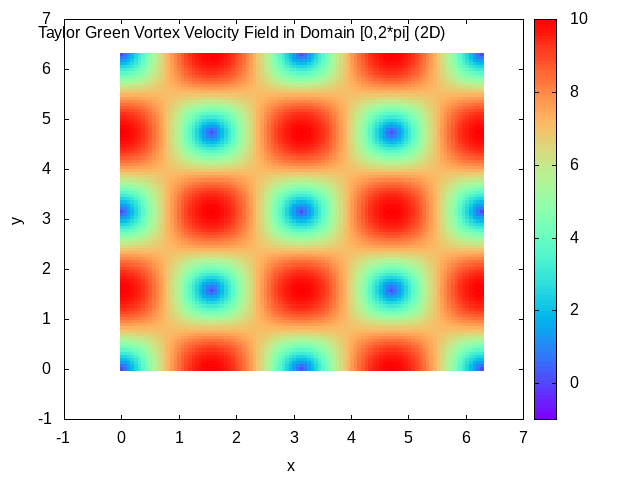Taylor–Green Vortex on:
[Wikipedia]
[Google]
[Amazon]
 In fluid dynamics, the Taylor–Green vortex is an unsteady flow of a decaying
In fluid dynamics, the Taylor–Green vortex is an unsteady flow of a decaying

 In fluid dynamics, the Taylor–Green vortex is an unsteady flow of a decaying
In fluid dynamics, the Taylor–Green vortex is an unsteady flow of a decaying vortex
In fluid dynamics, a vortex ( : vortices or vortexes) is a region in a fluid in which the flow revolves around an axis line, which may be straight or curved. Vortices form in stirred fluids, and may be observed in smoke rings, whirlpools in t ...
, which has an exact closed form solution of the incompressible Navier–Stokes equations in Cartesian coordinates
A Cartesian coordinate system (, ) in a plane is a coordinate system that specifies each point uniquely by a pair of numerical coordinates, which are the signed distances to the point from two fixed perpendicular oriented lines, measured i ...
. It is named after the British physicist and mathematician Geoffrey Ingram Taylor
Sir Geoffrey Ingram Taylor OM FRS FRSE (7 March 1886 – 27 June 1975) was a British physicist and mathematician, and a major figure in fluid dynamics and wave theory. His biographer and one-time student, George Batchelor, described him as ...
and his collaborator A. E. Green
Albert Edward Green (11 November 1912, London – 12 August 1999) was a British applied mathematician and research scientist in theoretical and applied mechanics.
Biography
Green studied mathematics at Jesus College, Cambridge, where he attend ...
.
Taylor, G. I. and Green, A. E., ''Mechanism of the Production of Small Eddies from Large Ones'', Proc. R. Soc. Lond. A, 158, 499–521 (1937).
Original work
In the original work of Taylor and Green, a particular flow is analyzed in three spatial dimensions, with the three velocity components at time specified by : : : The continuity equation determines that . The small time behavior of the flow is then found through simplification of the incompressible Navier–Stokes equations using the initial flow to give a step-by-step solution as time progresses. An exact solution in two spatial dimensions is known, and is presented below.
Incompressible Navier–Stokes equations
The incompressible Navier–Stokes equations in the absence ofbody force
In physics, a body force is a force that acts throughout the volume of a body.
Springer site - Book 'Solid mechanics'preview paragraph 'Body forces'./ref>
Forces due to gravity, electric fields and magnetic fields are examples of body forces. ...
, and in two spatial dimensions, are given by
:
:
:
The first of the above equation represents the continuity equation
A continuity equation or transport equation is an equation that describes the transport of some quantity. It is particularly simple and powerful when applied to a conserved quantity, but it can be generalized to apply to any extensive quantity. ...
and the other two represent the momentum equations.
Taylor–Green vortex solution
In the domain , the solution is given by : where , being thekinematic viscosity
The viscosity of a fluid is a measure of its resistance to deformation at a given rate. For liquids, it corresponds to the informal concept of "thickness": for example, syrup has a higher viscosity than water.
Viscosity quantifies the intern ...
of the fluid. Following the analysis of Taylor and Green for the two-dimensional situation, and for , gives agreement with this exact solution, if the exponential is expanded as a Taylor series
In mathematics, the Taylor series or Taylor expansion of a function is an infinite sum of terms that are expressed in terms of the function's derivatives at a single point. For most common functions, the function and the sum of its Taylor se ...
, i.e. .
The pressure field can be obtained by substituting the velocity solution in the momentum equations and is given by
:
The stream function
The stream function is defined for incompressible ( divergence-free) flows in two dimensions – as well as in three dimensions with axisymmetry. The flow velocity components can be expressed as the derivatives of the scalar stream function. ...
of the Taylor–Green vortex solution, i.e. which satisfies for flow velocity , is
:
Similarly, the vorticity
In continuum mechanics, vorticity is a pseudovector field that describes the local spinning motion of a continuum near some point (the tendency of something to rotate), as would be seen by an observer located at that point and traveling along w ...
, which satisfies , is given by
:
The Taylor–Green vortex solution may be used for testing and validation of temporal accuracy of Navier–Stokes algorithms.
A generalization of the Taylor–Green vortex solution in three dimensions in described in.
References
{{DEFAULTSORT:Taylor-Green vortex Fluid dynamics Computational fluid dynamics